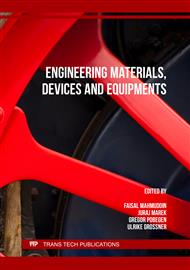p.3
p.13
p.23
p.33
p.41
p.51
p.57
p.69
p.77
The Influence of Machining Variables on the Quality of the Shaping Process on Hard Steel
Abstract:
The product quality of hard steel material formed by a shaping machine using HSS tools was studied under the influence of machining variables. The research focused on the effects of tool vibration on the surface roughness of the product. The experimental process was carried out by selecting the machining independent variables, namely: cutting speed (V) = 1 m/min; 2 m/min; 3 m/min; cutting thickness (a) = 1 mm, 1.5 mm, 2 mm; feeding motion (f) = 5 mm/step; 8mm/step; 10 mm/step. Shaping machine was operated with 3 fixed speed levels (n) of 21.8 rpm, 39 rpm and 59.8 rpm, respectively. The dependent variable, namely stroke per minute (np); and feed rate (Vf). The material used was ASTM A483-A high carbon steel. Vibration measurements were taken during machining using an ADXL 345 accelerometer and an Arduino Pro Mini with support for Arduino IDE 1.8.13 and USB TTL CP 2120 software. Vibration acceleration (af) on the tool was recorded and an evaluation was performed to determine the effects of machining variables on the final products. The results show that speed lavel of machine, feed rate , and cutting thickness majorly affect vibration. The lowest vibration was obtained at a speed (n) of 21.8 rpm, a feed rate (Vf) of 1 mm/s, and cutting thickness (a) of 0.2 mm. The highest vibration was obtained at n of 59.6 rpm, Vf = 1 mm/s and a of 0.4 mm. The quality of the product related to the surface roughness was mainly influenced by the machine speed levels. The roughness values ranged from 3.97 to 6.46 µm, with the lowest surface roughness or smoother surface achieved at a moderate speed of 39 rpm and higher surface roughness at high (59.8 rpm) and low (21.8 rpm) speeds.
Info:
Periodical:
Pages:
41-47
Citation:
Online since:
June 2023
Authors:
Keywords:
Price:
Сopyright:
© 2023 Trans Tech Publications Ltd. All Rights Reserved
Share:
Citation:



